
Humulus, hop, is a small genus of flowering plants in the family Cannabaceae. The hop is native to temperate regions of the Northern Hemisphere. Hops are the female flowers of the hop species H. lupulus; as a main flavor and aroma ingredient in many beer styles, H. lupulus is widely cultivated for use by the brewing industry.

Lycaenidae is the second-largest family of butterflies, with over 6,000 species worldwide, whose members are also called gossamer-winged butterflies. They constitute about 30% of the known butterfly species.

The common swift is a moth of the family Hepialidae. It was previously placed in the genus Hepialus. It is a common, often abundant European species. The species was described by Carl Linnaeus in his 1758 10th edition of Systema Naturae.
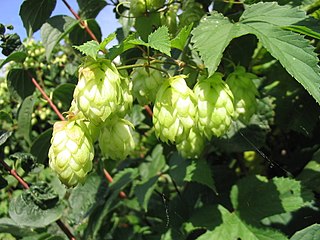
Humulus lupulus, the common hop or hops, is a species of flowering plant in the hemp family Cannabinaceae, native to West Asia, Europe and North America. It is a perennial, herbaceous climbing plant which sends up new shoots in early spring and dies back to a cold-hardy rhizome in autumn. It is dioecious.

The holly blue is a butterfly that belongs to the lycaenids or blues family and is native to the Palearctic.

Polygonia interrogationis, commonly called the question mark butterfly, is a North American nymphalid butterfly. It lives in wooded areas, city parks, generally in areas with a combination of trees and open space. The color and textured appearance of the underside of its wings combine to provide camouflage that resembles a dead leaf. The adult butterfly has a wingspan of 4.5–7.6 cm (1.8–3.0 in). Its flight period is from May to September. "The silver mark on the underside of the hindwing is broken into two parts, a curved line and a dot, creating a ?-shaped mark that gives the species its common name."
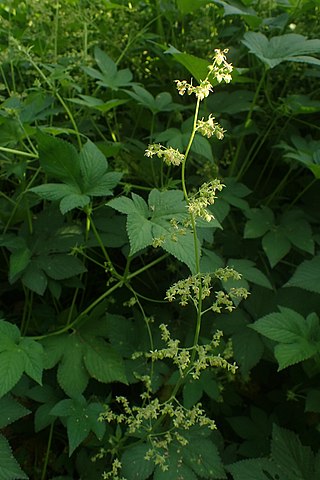
Humulus japonicus, known as Japanese hops, is an ornamental plant in the family Cannabaceae. Some authorities have it as a synonym of Humulus scandens.

Celastrina is a genus of butterflies in the family Lycaenidae found in the Palearctic, Nearctic, Indomalayan and Australasian realms.

The Appalachian azure is a butterfly in the gossamer wings family Lycaenidae. The male is light blue on the upperwing with a narrow, dark line running along the edge of the forewing. The underwing is chalky white and is dotted with small, pale dark spots. The very back of the hindwing has a row of dark spots running along the edge and contained by a faint zigzagging band. Females are similar to the males but have broad dark wing borders instead of the male's narrow ones. The adult butterfly has a 1.1–1.4-inch (2.8–3.6 cm) wingspan. It is the largest azure in the area.

Celastrina ladon, the spring azure or echo blue, is a butterfly of the family Lycaenidae. It is found in North America from Alaska and Canada south of the tundra, through most of the United States except the Texas coast, southern plain and peninsula Florida; south in the mountains to Colombia. Also on Molokai island, Hawaii.

Polygonia faunus, the green comma, Faunus comma, or Faunus anglewing is a butterfly of the family Nymphalidae.

Celastrina neglecta, the summer azure, is a butterfly of the family Lycaenidae. It is found in North America. Layberry, Hall, and Lafontaine, in The Butterflies of Canada, describe the species:
The upper surface is pale blue with an extensive dusting of white scales, especially on the hindwing. In some females the blue is almost entirely replaced by white with a small amount of blue near the wing bases. Females have a broad blackish-grey band on the outer third and costa of the forewing. The underside is chalky white to pale grey with tiny dark grey spots and a zigzagged submarginal line on the hindwing.
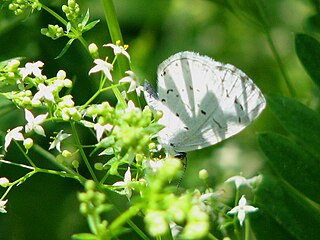
Celastrina serotina, the cherry gall azure, is a butterfly of the family Lycaenidae. It is found across North America as far north as the treeline. Its flight time is between mid-May and mid-June in eastern Ontario after the spring azure and before the summer azure. The larva has been reported to feed on galls of eriophyid mites and apparently also on the mites themselves, making them one of the rare species of carnivorous Lepidoptera. It is commonly found around woodland roads of upland mixed deciduous hardwood forests which are surrounded by wetlands.
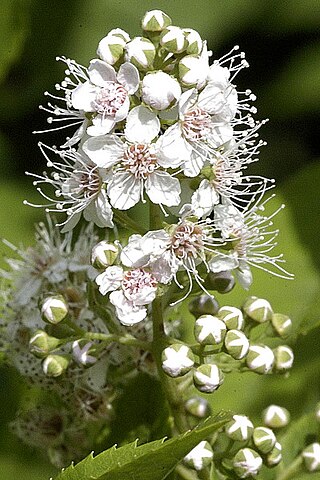
Spiraea alba, commonly known as meadowsweet, white meadowsweet, narrowleaf meadowsweet, pale bridewort, or pipestem, is native to the wet soils of the Allegheny Mountains and other portions of eastern North America, but is currently endangered in the state of Missouri. It is naturalized in other parts of the world.
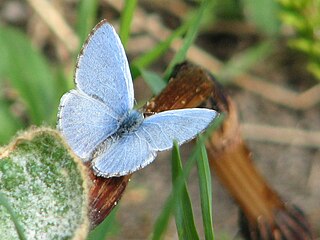
Celastrina lucia, the lucia azure, northern azure, eastern spring azure or northern spring azure, is a species of butterfly of the family Lycaenidae. It is found eastern North America, ranging from the Maritimes south through the Appalachian Mountains to West Virginia.

Celastrina gozora, the Mexican azure, is a butterfly of the family Lycaenidae. It is found in Mexico, Panama, and Honduras.

Celastrina idella, the American holly azure, is a species of butterfly of the family Lycaenidae. It is found on the east coast of the United States.

Celastrina echo, known generally as the echo azure or western azure, is a species of blue in the butterfly family Lycaenidae.
Celastrina nigra, the dusky azure, is a butterfly in the family Lycaenidae. The species was first described by William Trowbridge Merrifield Forbes in 1960. It resides in the extreme northeast corner of the U.S. state of Georgia. The larval host plant is Aruncus dioicus.
















